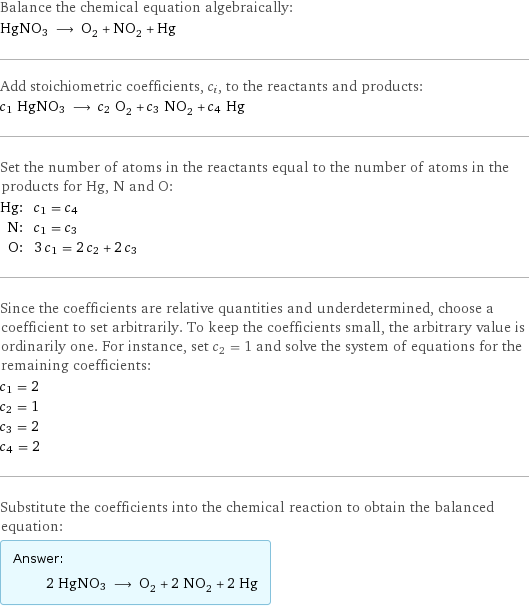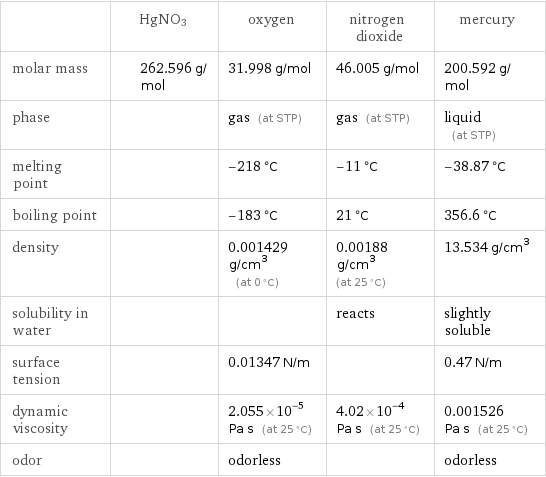Input interpretation

HgNO3 ⟶ O_2 oxygen + NO_2 nitrogen dioxide + Hg mercury
Balanced equation

Balance the chemical equation algebraically: HgNO3 ⟶ O_2 + NO_2 + Hg Add stoichiometric coefficients, c_i, to the reactants and products: c_1 HgNO3 ⟶ c_2 O_2 + c_3 NO_2 + c_4 Hg Set the number of atoms in the reactants equal to the number of atoms in the products for Hg, N and O: Hg: | c_1 = c_4 N: | c_1 = c_3 O: | 3 c_1 = 2 c_2 + 2 c_3 Since the coefficients are relative quantities and underdetermined, choose a coefficient to set arbitrarily. To keep the coefficients small, the arbitrary value is ordinarily one. For instance, set c_2 = 1 and solve the system of equations for the remaining coefficients: c_1 = 2 c_2 = 1 c_3 = 2 c_4 = 2 Substitute the coefficients into the chemical reaction to obtain the balanced equation: Answer: | | 2 HgNO3 ⟶ O_2 + 2 NO_2 + 2 Hg
Structures

HgNO3 ⟶ + +
Names

HgNO3 ⟶ oxygen + nitrogen dioxide + mercury
Equilibrium constant
![Construct the equilibrium constant, K, expression for: HgNO3 ⟶ O_2 + NO_2 + Hg Plan: • Balance the chemical equation. • Determine the stoichiometric numbers. • Assemble the activity expression for each chemical species. • Use the activity expressions to build the equilibrium constant expression. Write the balanced chemical equation: 2 HgNO3 ⟶ O_2 + 2 NO_2 + 2 Hg Assign stoichiometric numbers, ν_i, using the stoichiometric coefficients, c_i, from the balanced chemical equation in the following manner: ν_i = -c_i for reactants and ν_i = c_i for products: chemical species | c_i | ν_i HgNO3 | 2 | -2 O_2 | 1 | 1 NO_2 | 2 | 2 Hg | 2 | 2 Assemble the activity expressions accounting for the state of matter and ν_i: chemical species | c_i | ν_i | activity expression HgNO3 | 2 | -2 | ([HgNO3])^(-2) O_2 | 1 | 1 | [O2] NO_2 | 2 | 2 | ([NO2])^2 Hg | 2 | 2 | ([Hg])^2 The equilibrium constant symbol in the concentration basis is: K_c Mulitply the activity expressions to arrive at the K_c expression: Answer: | | K_c = ([HgNO3])^(-2) [O2] ([NO2])^2 ([Hg])^2 = ([O2] ([NO2])^2 ([Hg])^2)/([HgNO3])^2](../image_source/0a87e959543a336c81d122a5d9fa5a6c.png)
Construct the equilibrium constant, K, expression for: HgNO3 ⟶ O_2 + NO_2 + Hg Plan: • Balance the chemical equation. • Determine the stoichiometric numbers. • Assemble the activity expression for each chemical species. • Use the activity expressions to build the equilibrium constant expression. Write the balanced chemical equation: 2 HgNO3 ⟶ O_2 + 2 NO_2 + 2 Hg Assign stoichiometric numbers, ν_i, using the stoichiometric coefficients, c_i, from the balanced chemical equation in the following manner: ν_i = -c_i for reactants and ν_i = c_i for products: chemical species | c_i | ν_i HgNO3 | 2 | -2 O_2 | 1 | 1 NO_2 | 2 | 2 Hg | 2 | 2 Assemble the activity expressions accounting for the state of matter and ν_i: chemical species | c_i | ν_i | activity expression HgNO3 | 2 | -2 | ([HgNO3])^(-2) O_2 | 1 | 1 | [O2] NO_2 | 2 | 2 | ([NO2])^2 Hg | 2 | 2 | ([Hg])^2 The equilibrium constant symbol in the concentration basis is: K_c Mulitply the activity expressions to arrive at the K_c expression: Answer: | | K_c = ([HgNO3])^(-2) [O2] ([NO2])^2 ([Hg])^2 = ([O2] ([NO2])^2 ([Hg])^2)/([HgNO3])^2
Rate of reaction
![Construct the rate of reaction expression for: HgNO3 ⟶ O_2 + NO_2 + Hg Plan: • Balance the chemical equation. • Determine the stoichiometric numbers. • Assemble the rate term for each chemical species. • Write the rate of reaction expression. Write the balanced chemical equation: 2 HgNO3 ⟶ O_2 + 2 NO_2 + 2 Hg Assign stoichiometric numbers, ν_i, using the stoichiometric coefficients, c_i, from the balanced chemical equation in the following manner: ν_i = -c_i for reactants and ν_i = c_i for products: chemical species | c_i | ν_i HgNO3 | 2 | -2 O_2 | 1 | 1 NO_2 | 2 | 2 Hg | 2 | 2 The rate term for each chemical species, B_i, is 1/ν_i(Δ[B_i])/(Δt) where [B_i] is the amount concentration and t is time: chemical species | c_i | ν_i | rate term HgNO3 | 2 | -2 | -1/2 (Δ[HgNO3])/(Δt) O_2 | 1 | 1 | (Δ[O2])/(Δt) NO_2 | 2 | 2 | 1/2 (Δ[NO2])/(Δt) Hg | 2 | 2 | 1/2 (Δ[Hg])/(Δt) (for infinitesimal rate of change, replace Δ with d) Set the rate terms equal to each other to arrive at the rate expression: Answer: | | rate = -1/2 (Δ[HgNO3])/(Δt) = (Δ[O2])/(Δt) = 1/2 (Δ[NO2])/(Δt) = 1/2 (Δ[Hg])/(Δt) (assuming constant volume and no accumulation of intermediates or side products)](../image_source/ad9e3cdccca7e1f4225bd9b80ab8bdd5.png)
Construct the rate of reaction expression for: HgNO3 ⟶ O_2 + NO_2 + Hg Plan: • Balance the chemical equation. • Determine the stoichiometric numbers. • Assemble the rate term for each chemical species. • Write the rate of reaction expression. Write the balanced chemical equation: 2 HgNO3 ⟶ O_2 + 2 NO_2 + 2 Hg Assign stoichiometric numbers, ν_i, using the stoichiometric coefficients, c_i, from the balanced chemical equation in the following manner: ν_i = -c_i for reactants and ν_i = c_i for products: chemical species | c_i | ν_i HgNO3 | 2 | -2 O_2 | 1 | 1 NO_2 | 2 | 2 Hg | 2 | 2 The rate term for each chemical species, B_i, is 1/ν_i(Δ[B_i])/(Δt) where [B_i] is the amount concentration and t is time: chemical species | c_i | ν_i | rate term HgNO3 | 2 | -2 | -1/2 (Δ[HgNO3])/(Δt) O_2 | 1 | 1 | (Δ[O2])/(Δt) NO_2 | 2 | 2 | 1/2 (Δ[NO2])/(Δt) Hg | 2 | 2 | 1/2 (Δ[Hg])/(Δt) (for infinitesimal rate of change, replace Δ with d) Set the rate terms equal to each other to arrive at the rate expression: Answer: | | rate = -1/2 (Δ[HgNO3])/(Δt) = (Δ[O2])/(Δt) = 1/2 (Δ[NO2])/(Δt) = 1/2 (Δ[Hg])/(Δt) (assuming constant volume and no accumulation of intermediates or side products)
Chemical names and formulas

| HgNO3 | oxygen | nitrogen dioxide | mercury formula | HgNO3 | O_2 | NO_2 | Hg name | | oxygen | nitrogen dioxide | mercury IUPAC name | | molecular oxygen | Nitrogen dioxide | mercury
Substance properties

| HgNO3 | oxygen | nitrogen dioxide | mercury molar mass | 262.596 g/mol | 31.998 g/mol | 46.005 g/mol | 200.592 g/mol phase | | gas (at STP) | gas (at STP) | liquid (at STP) melting point | | -218 °C | -11 °C | -38.87 °C boiling point | | -183 °C | 21 °C | 356.6 °C density | | 0.001429 g/cm^3 (at 0 °C) | 0.00188 g/cm^3 (at 25 °C) | 13.534 g/cm^3 solubility in water | | | reacts | slightly soluble surface tension | | 0.01347 N/m | | 0.47 N/m dynamic viscosity | | 2.055×10^-5 Pa s (at 25 °C) | 4.02×10^-4 Pa s (at 25 °C) | 0.001526 Pa s (at 25 °C) odor | | odorless | | odorless
Units
